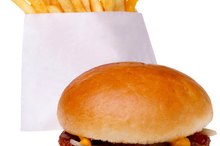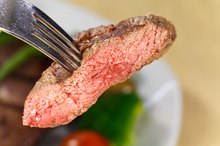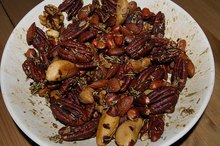Food Absorption & Fat Emulsification in the Digestive System
To benefit from the nutrient molecules in food, you must absorb them into your body where they can nourish your cells. Several different mechanisms for facilitate the absorption of nutrient molecules. To absorb fat, it must first be digested, which is dependent upon a process called emulsification.
Digestion
Prior to absorbing most of the components in your food, you must break down large molecules into smaller ones that can be taken into the bloodstream. Some simple sugars, such as glucose, do not require digestion prior to absorption. Table sugar, starches, proteins and fats must be broken down first. Digestion of carbohydrates begins in the mouth; protein digestion starts in the stomach. Fat digestion does not begin until it reaches the small intestine, explains Dr. Lauralee Sherwood in her book, “Human Physiology.”
Fat Emulsification
Bile and Fat Digestion
Learn More
Carbohydrates and proteins dissolve in water, which allows digestive enzymes to go to work on them, but fat does not. Your liver produces a substance called bile, which is secreted into the small intestine. This breaks up fat in a process called emulsification, which effectively make the fats water-soluble. Digestive enzymes in the small intestine can then break them down.
Absorption of Carbohydrate and Protein
Carbohydrates and proteins are absorbed in the small intestine, but their component molecules -- monosaccharides and amino acids, respectively -- cannot pass through the cell membranes of the small intestine into the bloodstream. Transporter proteins in the cells lining the small intestine use sodium to help move monosaccharides and amino acids into the blood, explains Dr. Gary Thibodeau in his book, “Anatomy and Physiology.”
Absorption of Fats
The Digestive & Circulatory Systems Converting Food Into Energy
Learn More
Triglycerides, the fat molecules in food, consist of a backbone molecule called glycerol bound to three molecules called fatty acids. When you digest fat, it breaks down into two fatty acids and a monoglyceride, which is a glycerol with one fatty acid attached. These molecules do not need to be transported across the small intestine lining; they can migrate directly into the cells of the lining. From there, they proceed into the lymphatic system and eventually make their way into the bloodstream.
Related Articles
References
- “Human Physiology”; Lauralee Sherwood, Ph.D.; 2004
- “Anatomy and Physiology”; Gary Thibodeau, Ph.D.; 2007
- “Biochemistry”; Reginald Garrett, Ph.D., and Charles Grisham, Ph.D.; 2007
Writer Bio
Kirstin Hendrickson is a writer, teacher, coach, athlete and author of the textbook "Chemistry In The World." She's been teaching and writing about health, wellness and nutrition for more than 10 years. She has a Bachelor of Science in zoology, a Bachelor of Science in psychology, a Master of Science in chemistry and a doctoral degree in bioorganic chemistry.









